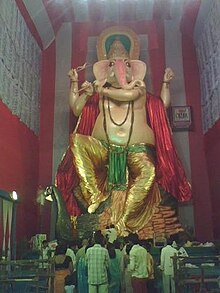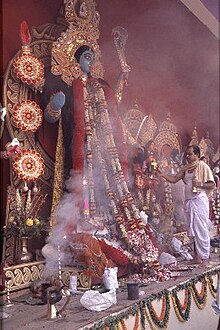가네샤
위키백과, 우리 모두의 백과사전.
신앙[편집]
가네샤는 인도 전통의 복장을 한 남자의 몸에 네개의 팔을 지녔으며 코끼리 머리를 하고 있다. 인도에서는 지혜와 재산을 관장하는 신으로 추앙받고 있어 주로 상업과 학문의 신으로 숭배된다. 인도의 마하슈트라 지방에서 많은 신자를 갖고 있다.
호칭[편집]
가네샤는 가나파티(산스크리트어: गणपति Gaṇapati) · 비흐네슈바라(산스크리트어: विघ्नेश्वर Vighneśvara) 등 여러 이름으로 불린다. 흔히 이름 앞에 슈리 또는 시리를 붙여 슈리 가네샤(산스크리트어: श्री गणेश Śrī Gaṇeśa)라고 부른다.
신화[편집]
Ganesh Chaturthi
From Wikipedia, the free encyclopedia
| This article needs additional citations for verification. (September 2011) |
| Ganesh Chaturthi | |
|---|---|

Ganesh Festival, Mumbai
| |
| Observed by | Hindus |
| Type | Religious/folk |
| Begins | Bhadrapada shukla chaturthi |
| Ends | Anant Chaturdashi |
| Date | August/September |
| 2012 date | 19 September |
| 2013 date | 9 September |
| Celebrations | Setting up Pandals, street processions and idol immersion |
Ganesha Chaturthi is the Hindu festival celebrated on the birthday (rebirth) of the god Ganesha, the son of Shiva andParvati.
It is believed that Lord Ganesh bestows his presence on earth for all his devotees during this festival. It is the day when Ganesha was born. Ganesha is widely worshipped as the god of wisdom, prosperity and good fortune and traditionally invoked at the beginning of any new venture or at the start of travel. The festival, also known as Vinayaka Chaturthi("festival of Ganesha") is observed in the Hindu calendarmonth of Bhaadrapada, starting on the shukla chaturthi (fourth day of the waxing moon period). The date usually falls between 19 August and 20 September. The festival lasts for 10 days, ending on Anant Chaturdashi (fourteenth day of the waxing moon period).
While celebrated all over India, it is most elaborate inMaharashtra, Gujarat, Tamil Nadu, Goa,[1] Andhra Pradesh,Karnataka, Odisha and Chhattisgarh. Outside India, it is celebrated widely in Nepal and by Hindus in the United States,Canada, Mauritius,[2] Singapore, Malaysia, Thailand,Cambodia, Burma, Fiji, Trinidad & Tobago, and Guyana.
Contents
[hide]Legend
Main article: Ganesha
Traditional Ganesha Hindu stories tell that Lord Ganesha was created by goddess Parvati consort of Shiva. Parvati created Ganesha out of sandalwood paste that she used for her bath and breathed life into the figure. She then set him to stand guard at her door while she bathed. Lord Shiva, who had gone out, returned and as Ganesha didn't know him, didn't allow him to enter. Lord Shiva became enraged by this and asked his follower Ganas to teach the child some manners. Ganesha who was very powerful, being born of Parvati, the embodiment of Shakti, defeated Shiva's followers and declared that nobody was allowed to enter while his mother was bathing. The sage of heavens, Narada along with the Saptarishis sensed the growing turmoil and went to appease the boy with no results. Angered, the king of Gods, Indra attacked the boy with his entire heavenly army but even they didn't stand a chance. By then, this issue had become a matter of pride for Parvati and Shiva. Angry Shiva severed the head of the child. Parvati seeing this became enraged. Seeing Parvati in anger Shiva promised that her son will be alive again. The devas searched for the head of dead person facing North. But they found only the head of a dead elephant. They brought the head of the elephant and Shiva fixed it on the child's body and brought him back to life. Lord Shiva also declared that from this day the boy would be called Ganesha (Gana Isha : Lord of Ganas).[3]
According to the Linga Purana, Ganesha was created by Lord Shiva and Goddess Parvati at the request of the Devas for being a Vighnakartaa (obstacle-creator) in the path of Rakshasas, and a Vighnahartaa (obstacle-averter) to help the Devas achieve fruits of their hard work.[4]
Date
The festival is observed in the Hindu calendar month of Bhaadrapada, starting on the shukla chaturthi (fourth day of the waxing moon). The date usually falls between 19 August and 20 September. The festival lasts for 10 or 12 days, ending on Anant Chaturdashi. This festival is observed in the lunar month of bhadrapada shukla paksha chathurthi madhyahana vyapini purvaviddha. If Chaturthi prevails on both days, the first day should be observed. Even if chaturthi prevails for the complete duration of madhyahana on the second day, if it prevails on the previous day's madhyahana period even for one ghatika (24 minutes), the previous day should be observed.[5]
Celebration, rituals and tradition
Two to three weeks before Ganesh Chaturthi, artistic clay models of Lord Ganesha are made for sale by specially skilled artisans. They are beautifully decorated and depict Lord Ganesh in vivid poses. The size of these statues may vary from 3/4 of an inch to over 70 feet. The tallest Ganesha Idol made which stood 117 feet tall was situated in the city of Visakhapatnam in 2012.
Ganesh Chaturthi starts with the installation of these Ganesh statues in colorfully decorated homes and specially erected temporary structures mandapas (pandals) in every locality. The pandals are erected by the people or a specific society or locality or group by collecting monetary contributions. Thepandals are decorated specially for the festival, either by using decorative items like flower garlands, lights, etc. or are theme based decorations, which depict religious themes or current events.
The priest, usually clad in red or white dhoti and uttariyam(Shawl), then with the chanting of mantras invokes the presence of Ganesha using the statue as a channel, or body for his energy. This ritual is the Pranapratishhtha. After this the ritual called as Shhodashopachara (16 ways of paying tribute) follows. Coconut, jaggery, 21 modaks, 21 durva (trefoil) blades of grass and red flowers are offered. The statue is anointed with red unguent, typically made of kumkum and sandalwood paste. Throughout the ceremony, Vedic hymns from the Rig Veda, the Ganapati Atharva Shirsha Upanishad, and the Ganesha stotra from the Narada Purana are chanted.
Some homes buy their own small clay statue, and after 1,3,5,7 or 11 days immerse it in a bucket or tub at home, so as not to pollute public lakes or rivers. After a few days the clay is used in the home garden.
The main sweet dish during the festival is the modak (modak in Marathi, modakam/kudumu in Telugu, modaka/kadubu in Kannada and modagam in Tamil). A modak is a dumpling made from rice flour/wheat flour with a stuffing of fresh or dry-grated coconut, jaggery, dry fruits and some other condiments. It is either steam-cooked or fried. Another popular sweet dish is the karanji (karjikai in Kannada) which is similar to themodak in composition and taste but has a semicircular shape.
In Andhra Pradesh, kudumu (rice flour dumplings stuffed with coconut and jaggery mixture), Vundrallu (steamed coarsely grounded rice flour balls), Panakam (jaggery, black pepper and cardamom flavored drink), Vadapappu (soaked and moong lentils), Chalividi (cooked rice flour and jaggery mixture), etc., are offered to Ganesha along with Modakams. These offerings to god are called Naivedyam in Telugu.
In Andhra Pradesh, Clay Ganesh (Matti Vinayakudu in Telugu) and Turmeric Ganesh (Siddhi Vinayakudu in Telugu) is usually worshipped at homes along with plaster of paris Ganesha.
Public celebrations of the festival are hugely popular, with local communities (mandalas) vying with each other to put up the biggest statue and the best pandal. The festival is also the time for cultural activities like singing and theater performances, orchestra and community activities like free medical checkup, blood donation camps, charity for the poor, etc.
Today, the Ganesh Festival is not only a popular festival, it has become a very critical and important economic activity for Mumbai, Visakhapatnam, Hyderabad, Bangalore and Chennai. Many artists, industries, and businesses survive on this mega-event. Ganesh Festival also provides a stage for budding artists to present their art to the public. In Maharashtra, not only Hindus but many other religions also participate in the celebration like Muslims, Jains, Christian and others. In Mangalore, there is a belief that the eldest son of the home should be present during pooja.
Puja (Hinduism)
From Wikipedia, the free encyclopedia
Pūjā or alternative transliteration Pooja, (Devanagari: पूजा) (Urdu: پوجا) (Sanskrit: reverence, honour, adoration, orworship) is a religious ritual performed by Hindus as an offering to various deities, distinguished persons, or special guests. This has also been followed by Buddhists and Sikhs to honour various beliefs. In Hinduism, it is done on a variety of occasions and settings, from daily puja done in the home, to temple ceremonies and large festivals, or to begin a new venture.[1]The two main areas where puja is performed is in the home and at public temples. There are many variations in scale, offering, and ceremony.[2] Puja is also performed on special occasions such as Durga Puja and Lakshmi Puja. The puja is performed by Hindus worldwide. Various poojas are performed at various times of the day and on various times.






댓글 없음:
댓글 쓰기